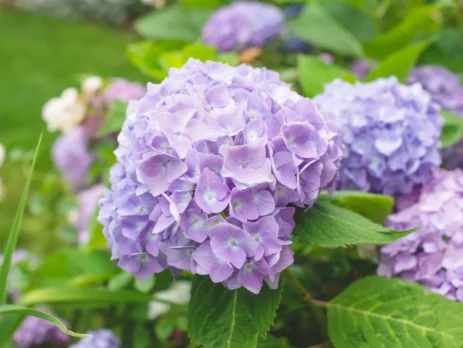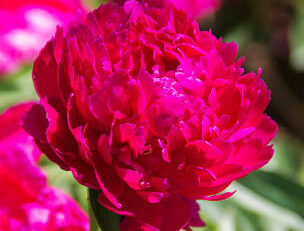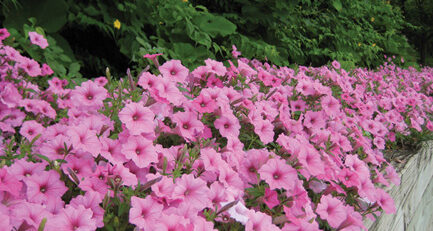Hydrangeas
If roses are the Queen of the Garden, hydrangeas surely are the King. Big, showy, dreamy flowers are the hallmark of this plant, and few flowering shrubs are more dramatic in the landscape. Hydrangea flowers are made up of a cluster of many smaller flowers to form what’s called a corymb. Each corymb has both sterile and fertile flowers. The lacecap form of hydrangea flowers is unusual as they are flat. The center florets are fertile, and the showy florets forming the outside ring are sterile.
Historical Significance
In the Victorian era, hydrangeas were thought of as vain because of their size and were considered a vulgar display. Rejected Victorian men gifted hydrangeas to women as an insult, although that custom is far gone by the wayside. In Japan, blue hydrangeas are given as love gifts, recalling an ancient emperor who gifted blue hydrangeas to a girl he loved to apologize for neglecting her.
Varieties and Origins
Like the rose, hydrangeas predate humanity. Sixty-five million-year-old fossil hydrangea have been found. Today, there are over 75 species of hydrangea that thrive in Europe, Asia, and North America. Hydrangea serrata, the Mountain Hydrangea, was first cultivated in Japan and Korea. The American native Hydrangea quercifolia is known as the oakleaf hydrangea. The oakleaf prefers a bit more temperate climate and is iffy on producing reliable blooms as it sets them prior to blooming season. Another native, the arborescens, is known as the smooth hydrangea. The smooth hydrangea is a more reliable bloomer because its flowers form on new growth. Both native species thrive in woodlands and grow well in part shade. Indigenous American cultures used the plant medicinally.
Popular Varieties
The most recognizable hydrangea flowers are the blue mopheads (P. macrophylla), so well-known on Cape Cod that they have an annual celebration in their honor. Another style of hydrangea is the lace cap, having a smaller, flatter center surrounded by a halo of separate hydrangea flowers. Panicle hydrangeas are the late flowering and showy whites with hints of pink and chartreuse. The oldest panicle variety is often found, old and woody, grown to 5-20 feet tall in gardens of early 1900s New England farmhouses. This old cultivar is most likely a type of Hydrangea paniculata ‘Grandiflora” which is sold as Peegee. It’s challenging to find these sturdy old plants in the trade today, but you may have luck growing one from a cutting.
Hydrangeas as Cut Flowers
A striking attribute of hydrangea’s showy flowers is their range of colors, including shades of blue, violet, purple, pink, white, cream, and green. Stems of hydrangea make a dramatic cut flower for centerpieces. The big blooms are chosen for weddings and included in gift bouquets. Hydrangea flowers create volume and drama, and they hold up very well if properly cared for. Even as the flowers age, they often fade to lovely antique shades, thus extending their use as a cut flower.
Taking Care of Hydrangea Cut Flowers
Hydrangea flowers from the florist are most likely treated to extend their life. When you receive them, it’s important to get them into water as soon as possible. Choose a sturdy vase that can support the weight of the blooms. Recut the stems with a sharp cutting tool like scissors or a knife. Remove leaves that will be submerged below the water line. Pour cool water into the vase and mix a good quality flower food into the water. Transfer your hydrangeas to the vase. Change the water in the vase every other day, making fresh cuts to the stem and add fresh flower food to the water. Display the vase in indirect light, which will prolong the life of the flowers.
If you cut hydrangeas from your own garden, there are several methods to keep them from wilting. One method is to use alum powder, which can be purchased at hardware or grocery stores that sell products for making pickles. Recut the end of the stem and dip the end into 1/2 inch of alum powder before placing it in a vase of water. Another method is to increase the surface area that takes up water by splitting the stem lengthwise for an inch and immediately placing it in cool water. Be sure to change the water every other day. If your hydrangeas still wilt, try placing the entire stem, leaves and flower heads, in enough water to cover them. Allow them to absorb the water in this way and then replace them in the vase.
Hydrangeas as Wedding Flowers
Hydrangea flowers have become very popular as bridal flowers, gracing bride’s bouquets, being woven onto a wedding arch, used as table top arrangements, or even adorning the wedding cake. If you plan to use hydrangeas as your signature wedding flower, it’s wise to purchase them from a florist. Even if planted in advance of your wedding, garden plants may not perform to your expectations in terms of producing the number, size, or color of blooms required. Florist-bought hydrangeas can be purchased fresh-cut in their naturally occurring colors with lovely tone and shading variations, or you may have them tinted in colors to match your wedding theme.
Arranging Hydrangeas
Arrangements with hydrangeas as the featured flower are always dramatic. Mophead hydrangea blooms look great when accented with spire-shaped flowers like delphiniums and bells of Ireland. For a more modern look, you can add ornamental grass plumes. Panicle and arborescens hydrangeas combine beautifully with roses, phlox, peony, carnations, or orchid sprays. For a bright, cheery display, add summery sunflowers and zinnias. To create a wedding bouquet with a romantic, antique feel, you can pair natural pink hydrangea with pink roses and peony. An elevated bride’s bouquet could combine chartreuse-white panicle hydrangeas with pale roses, delphinium, bells of Ireland, dusty miller, and eucalyptus.
Potted Hydrangeas
Potted hydrangeas are often available around Easter as gift plants. They can last for several weeks when kept in bright, indirect light. It’s important to keep them watered but not soaking wet, as excessive moisture may drown the roots. Remove the decorative foil and place them in a drainage saucer to monitor water overflow.
Spring flowering gift hydrangeas are forced in a warm greenhouse, so they are not usually winter hardy in New England. Some may survive a New England winter, but the cold spring winds in our climate often damage tender buds. If you want to try planting one in the garden, do so shortly after the flowers have faded. Plant it in a protected spot in part sun, near a heat-sink like a foundation or a walkway. Keep the plant watered through the summer, and in the fall, cover it entirely with mulch and burlap. It may not be worth the effort, but you never know! You might be surprised by a surviving plant.
For growing hydrange as in pots, panicle (P. paniculata) hydrangeas offer the best success. Plant them in large pots filled with well-drained, rich soil. Mophead hydrangeas may also be successfully grown in pots if treated as tender perennials and given heavy mulches for the winter. If the pots are a manageable size, they may be trenched. Trenching is a method of wintering over. Dig a hole the width and depth of the pot, and sink the pot into the ground, covering it all around with soil and mulch. In spring, remove the pot from the trench and expose it to the spring sun until it starts to leaf out. Then move it to a part shade area as the season warms up. Potted hydrangeas of all kinds require monitoring in the summer, as they require even more water than hydrangeas grown in garden soil. You may find yourself watering them twice a day in the heat of summer.
Cutting Hydrangea Stems from Your Garden
To extend the life of your hydrangea flowers, it’s wise to cut them early in the day when temperatures are cool. Choose full, mature flower heads, as they will add volume to your arrangements and their color will be the most saturated. Allow mophead and arborescens hydrangea plants to establish for several years before cutting. You may be able to cut panicle hydrangeas a bit sooner due to their vigorous plant habit.
Arborescens hydrangeas suitable for cutting include white ‘Annabelle’ and ‘Incrediball’. Pink arborescens ‘Blush’ has a lovely dusty pink color.
Bigleaf hydrangeas suitable for cutting include the classic blue Endless Summer brand ‘Balimer’, ‘Nantucket Blue’, and ‘Nikko Blue’, which only blooms on second-year stems. Cut ‘Nikko Blue’ higher on the stem, as it may produce additional smaller blooms from side shoots. Cut above a node to encourage late-season repeat blooming. Endless Summer’s ‘Twist and Shout’ is a lacecap hydrangea and will add an interesting twist to arrangements. Overall, hydrangea color is changeable. Depending on the time of the season, blue or purple mophead hydrangea flowers may have a bit of pink color, while later in the season, more green will appear. Sometimes flowers will age into lavender or purple colors. You may expect to see some color variation even on the same stem.
By following these tips, you can enjoy the beauty and versatility of hydrangeas in your garden, as cut flowers, or as potted plants. Their stunning blooms and range of colors make them a true treasure in any floral arrangement or landscape design.











